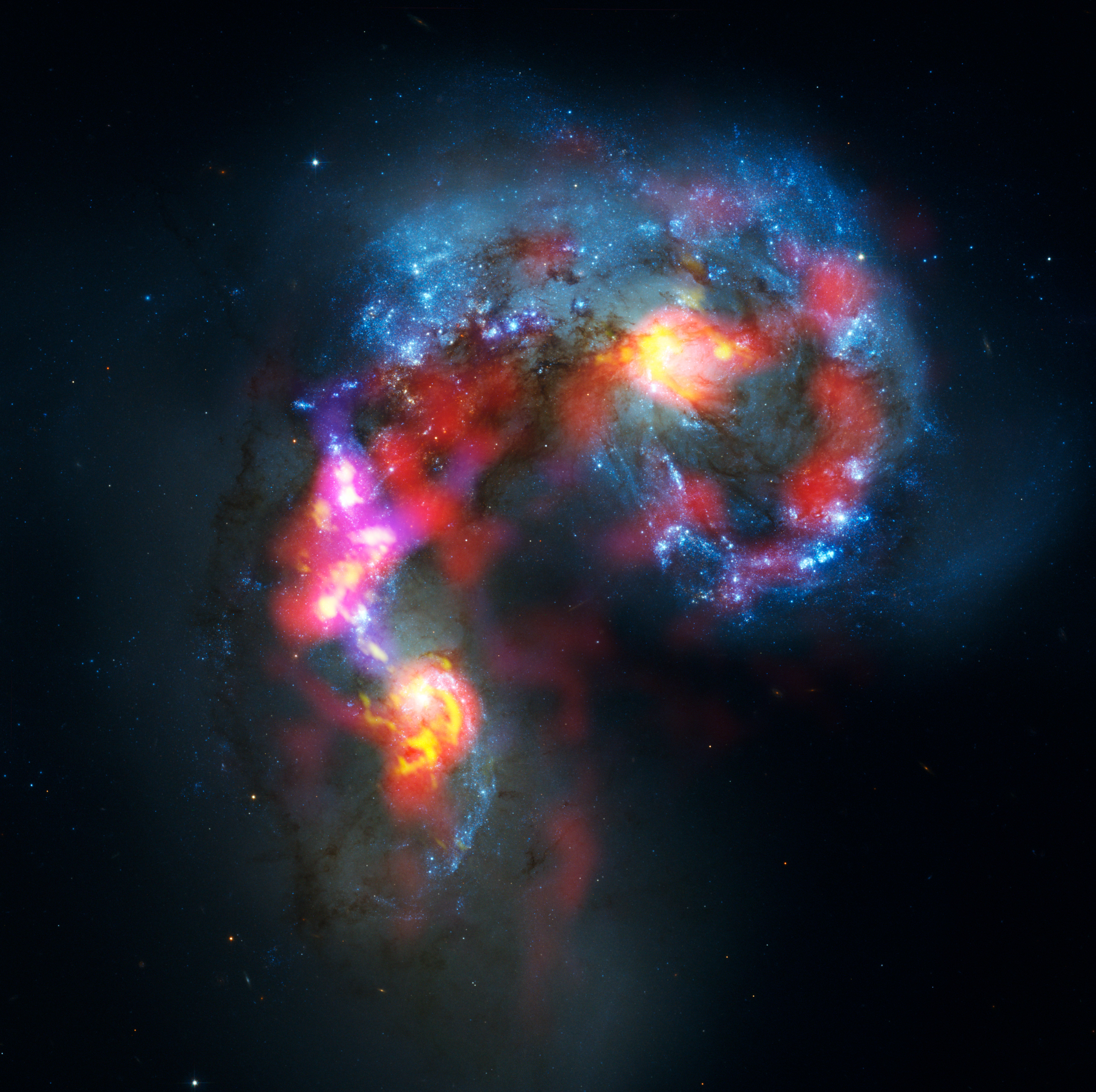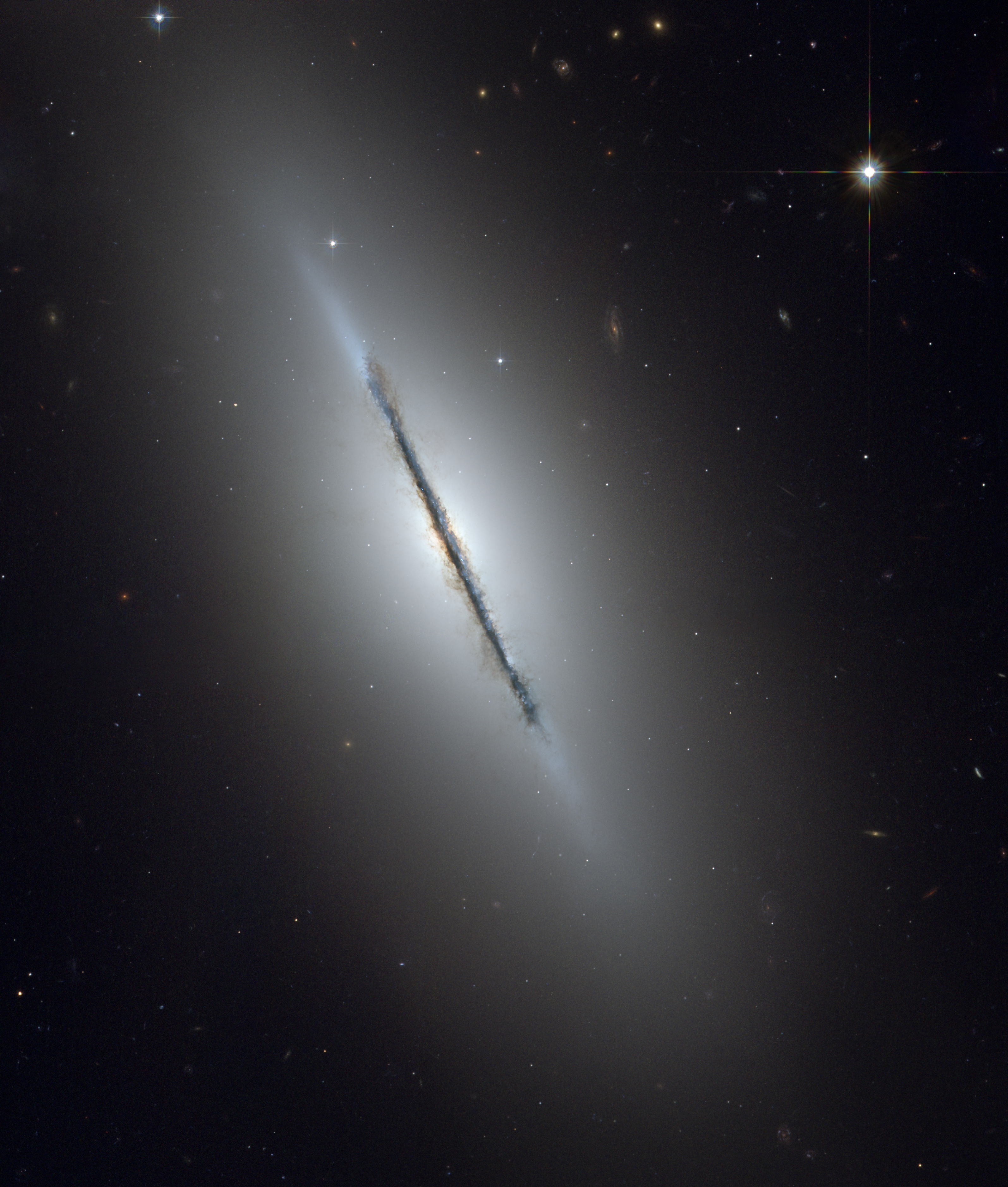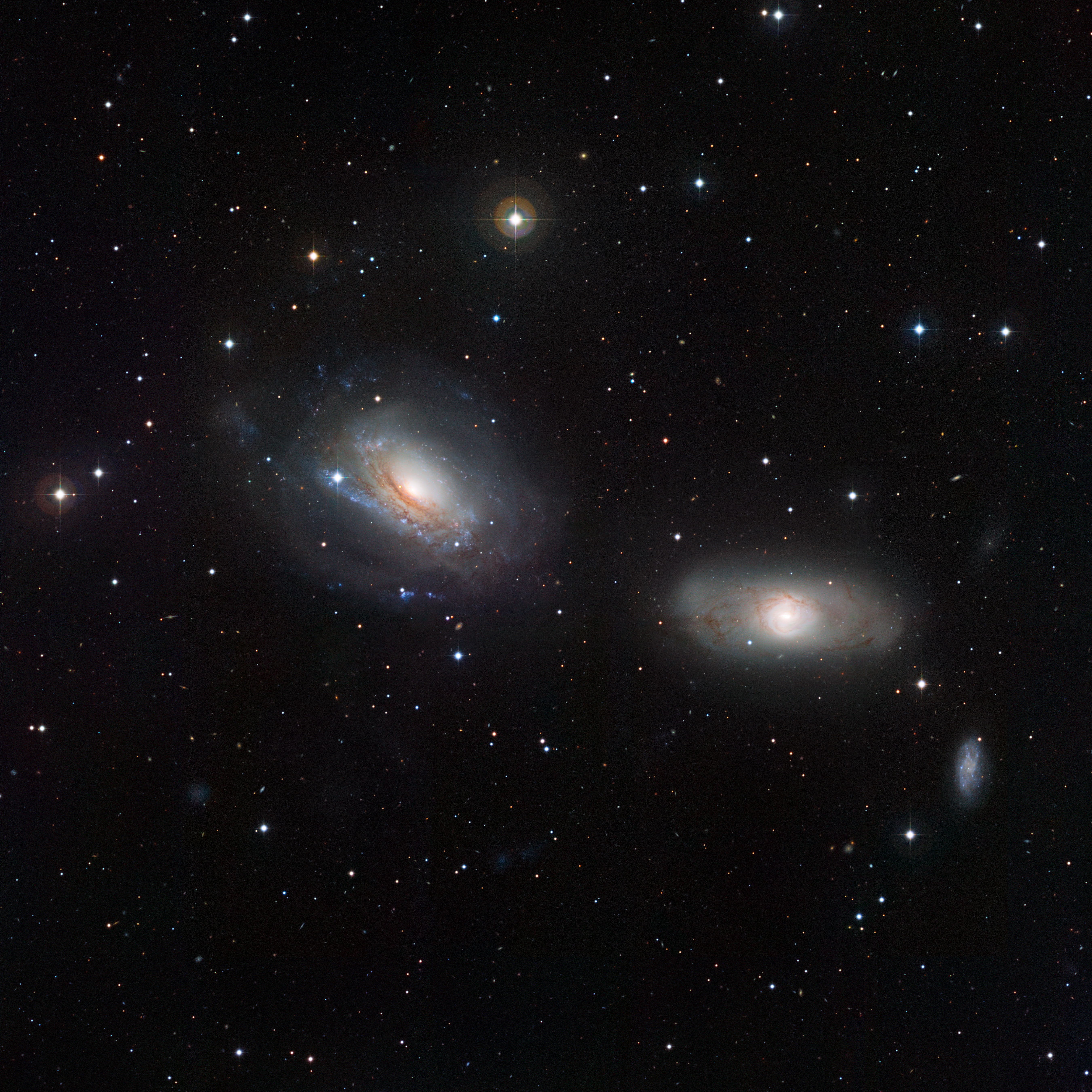|
NGC 4676
NGC 4676, or the Mice Galaxies, are two spiral galaxies in the constellation Coma Berenices. About 290 million light-years distant, they have begun the process of colliding and merging. Their "mice" name refers to the long tails produced by tidal action—the relative difference between gravitational pulls on the near and far parts of each galaxy—known here as a galactic tide. It is a possibility that both galaxies, which are members of the Coma Cluster, have experienced collision, and will continue colliding until they coalesce. The colors of the galaxies are peculiar. In NGC 4676A a core with some dark markings is surrounded by a bluish white remnant of spiral arms. The tail is unusual, starting out blue and terminating in a more yellowish color, despite the fact that the beginning of each arm in virtually every spiral galaxy starts yellow and terminates in a bluish color. NGC 4676B has a yellowish core and two arcs; arm remnants underneath are bluish as well. The galaxies w ... [...More Info...] [...Related Items...] OR: [Wikipedia] [Google] [Baidu] |
New General Catalogue
The ''New General Catalogue of Nebulae and Clusters of Stars'' (abbreviated NGC) is an astronomical catalogue of deep-sky objects compiled by John Louis Emil Dreyer in 1888. The NGC contains 7,840 objects, including galaxy, galaxies, star clusters and emission nebulae. Dreyer published two supplements to the NGC in 1895 and 1908, known as the ''Index Catalogues'' (abbreviated IC), describing a further 5,386 astronomical objects. Thousands of these objects are best known by their NGC or IC numbers, which remain in widespread use. The NGC expanded and consolidated the cataloguing work of William Herschel, William and Caroline Herschel, and John Herschel's ''General Catalogue of Nebulae and Clusters of Stars''. Objects south of the Celestial sphere, celestial equator are catalogued somewhat less thoroughly, but many were included based on observation by John Herschel or James Dunlop. The NGC contained multiple errors, but attempts to eliminate them were made by the ''Revised New Ge ... [...More Info...] [...Related Items...] OR: [Wikipedia] [Google] [Baidu] |
Antennae Galaxies
The Antennae Galaxies (also known as NGC 4038/NGC 4039 or Caldwell 60/Caldwell 61) are a pair of interacting galaxies in the constellation Corvus. They are currently going through a starburst phase, in which the collision of clouds of gas and dust, with entangled magnetic fields, causes rapid star formation. They were discovered by William Herschel in 1785. General information The Antennae Galaxies are undergoing a galactic collision. These interacting galaxies are located 0.25° north of 31 Crateris and 3.25° southwest of Gamma Corvi. A 2008 study found that they are less remote from the Milky Way than previously thought—at 45 million light-years instead of 65 million light-years. Located in the NGC 4038 group with five other galaxies, these two galaxies are known as the Antennae Galaxies because the two long tails of stars, gas and dust ejected from the galaxies as a result of the collision resemble an insect's antennae. The nuclei of the two galaxies are joini ... [...More Info...] [...Related Items...] OR: [Wikipedia] [Google] [Baidu] |
Principal Galaxies Catalogue Objects
Principal may refer to: Title or rank * Principal (academia), the chief executive of a university ** Principal (education), the head of a school * Principal (civil service) or principal officer, the senior management level in the UK Civil Service * Principal dancer, the top rank in ballet * Principal (music), the top rank in an orchestra Law * Principal (commercial law), the person who authorizes an agent ** Principal (architecture), licensed professional(s) with ownership of the firm * Principal (criminal law), the primary actor in a criminal offense * Principal (Catholic Church), an honorific used in the See of Lisbon Places * Principal, Cape Verde, a village * Principal, Ecuador, a parish Media * ''The Principal'' (TV series), a 2015 Australian drama series * ''The Principal'', a 1987 action film * Principal (music), the lead musician in a section of an orchestra * Principal photography, the first phase of movie production * "The Principal", a song on the album ''K- ... [...More Info...] [...Related Items...] OR: [Wikipedia] [Google] [Baidu] |
UGC Objects
UGC may refer to: Organisations * Canadian Geophysical Union, official abbreviation in French (Union géophysique canadienne) * UGC (cinema operator), a European cinema chain, formerly Union Générale Cinématographique * UGC Fox Distribution, a former French-American film production company formed in 1995 * Union Graduate College, Schenectady, New York * United Grain Company, a Russian grain trading company based in Moscow * University Grants Commission (other) * University Grants Committee (other) * UnitedGlobalCom, former name of the cable TV operator Liberty Global * UnderGround Crips, an African American street gang mainly from Los Angeles, California Science and technology * Universal gravitational constant G, in physics * Uppsala General Catalogue, an astronomical catalogue of galaxies * UGC, a codon for cysteine * Unique games conjecture, a conjecture in computational complexity Other * User-generated content User-generated content (UGC), a ... [...More Info...] [...Related Items...] OR: [Wikipedia] [Google] [Baidu] |
IC Objects
The ''New General Catalogue of Nebulae and Clusters of Stars'' (abbreviated NGC) is an astronomical catalogue of deep-sky objects compiled by John Louis Emil Dreyer in 1888. The NGC contains 7,840 objects, including galaxies, star clusters and emission nebulae. Dreyer published two supplements to the NGC in 1895 and 1908, known as the ''Index Catalogues'' (abbreviated IC), describing a further 5,386 astronomical objects. Thousands of these objects are best known by their NGC or IC numbers, which remain in widespread use. The NGC expanded and consolidated the cataloguing work of William and Caroline Herschel, and John Herschel's ''General Catalogue of Nebulae and Clusters of Stars''. Objects south of the celestial equator are catalogued somewhat less thoroughly, but many were included based on observation by John Herschel or James Dunlop. The NGC contained multiple errors, but attempts to eliminate them were made by the ''Revised New General Catalogue'' (RNGC) by Jack W. Sulenti ... [...More Info...] [...Related Items...] OR: [Wikipedia] [Google] [Baidu] |
NGC Objects
The ''New General Catalogue of Nebulae and Clusters of Stars'' (abbreviated NGC) is an astronomical catalogue of deep-sky objects compiled by John Louis Emil Dreyer in 1888. The NGC contains 7,840 objects, including galaxies, star clusters and emission nebulae. Dreyer published two supplements to the NGC in 1895 and 1908, known as the ''Index Catalogues'' (abbreviated IC), describing a further 5,386 astronomical objects. Thousands of these objects are best known by their NGC or IC numbers, which remain in widespread use. The NGC expanded and consolidated the cataloguing work of William and Caroline Herschel, and John Herschel's '' General Catalogue of Nebulae and Clusters of Stars''. Objects south of the celestial equator are catalogued somewhat less thoroughly, but many were included based on observation by John Herschel or James Dunlop. The NGC contained multiple errors, but attempts to eliminate them were made by the ''Revised New General Catalogue'' (RNGC) by Jack W. ... [...More Info...] [...Related Items...] OR: [Wikipedia] [Google] [Baidu] |
Barred Lenticular Galaxies
A lenticular galaxy (denoted S0) is a Galaxy morphological classification, type of galaxy intermediate between an elliptical galaxy, elliptical (denoted E) and a spiral galaxy in galaxy morphological classification schemes. It contains a large-scale disc but does not have large-scale spiral arms. Lenticular galaxies are Disc galaxy, disc galaxies that have used up or lost most of their interstellar matter and therefore have very little ongoing star formation. They may, however, retain significant dust in their disks. As a result, they consist mainly of aging stars (like elliptical galaxies). Despite the morphological differences, lenticular and elliptical galaxies share common properties like spectral features and scaling relations. Both can be considered early-type galaxies that are passively evolving, at least in the local part of the Universe. Connecting the E galaxies with the S0 galaxies are the ES galaxies with intermediate-scale discs. Morphology and structure Classific ... [...More Info...] [...Related Items...] OR: [Wikipedia] [Google] [Baidu] |
Irregular Galaxies
An irregular galaxy is a galaxy that does not have a distinct regular shape, unlike a spiral or an elliptical galaxy. Irregular galaxies do not fall into any of the regular classes of the Hubble sequence, and they are often chaotic in appearance, with neither a nuclear bulge nor any trace of spiral arm structure. This absence of structure in an irregular galaxy leads to little density waves in these galaxies. This makes irregular galaxies prime areas to study star formation without the effects of density waves. Collectively they are thought to make up about a quarter of all galaxies. Some irregular galaxies were once spiral or elliptical galaxies but were deformed by an uneven external gravitational force. Irregular galaxies may contain abundant amounts of gas and dust. This is not necessarily true for dwarf irregulars. Irregular galaxies may also be formed in galaxy collisions. Irregular galaxies are commonly small, about one tenth the mass of the Milky Way galaxy, though ther ... [...More Info...] [...Related Items...] OR: [Wikipedia] [Google] [Baidu] |
Interacting Galaxies
Interacting galaxies (''colliding galaxies'') are galaxies whose gravitational fields result in a disturbance of one another. Major mergers occur between galaxies with similar amounts of mass, whereas minor mergers involve galaxies with masses that vary significantly. An example of a minor interaction is a satellite galaxy disturbing the primary galaxy's spiral arms. An example of a major interaction is a galactic collision, which may lead to a galaxy merger. Satellite interaction A giant galaxy interacting with its satellites is common. A satellite's gravity could attract one of the primary's spiral arms. Alternatively, the secondary satellite can dive into the primary galaxy, as in the Sagittarius Dwarf Elliptical Galaxy diving into the Milky Way. That can possibly trigger a small amount of star formation. Such orphaned clusters of stars were sometimes referred to as "blue blobs" before they were recognized as stars. Galaxy collision Colliding galaxies are common during ... [...More Info...] [...Related Items...] OR: [Wikipedia] [Google] [Baidu] |
Peculiar Galaxies
A peculiar galaxy is a galaxy A galaxy is a Physical system, system of stars, stellar remnants, interstellar medium, interstellar gas, cosmic dust, dust, and dark matter bound together by gravity. The word is derived from the Ancient Greek, Greek ' (), literally 'milky', ... of unusual size, shape, or composition. Between five and ten percent of known galaxies are categorized as peculiar. Astronomers have identified two types of peculiar galaxies: ''interacting galaxies'' and ''active galactic nuclei'' (AGN). When two galaxies come close to each other, their mutual gravitational forces can cause them to acquire highly irregular shapes. The terms 'peculiar galaxy' and 'interacting galaxy' have now become synonymous because the majority of peculiar galaxies attribute their forms to such gravitational forces. Formation Scientists hypothesize that many peculiar galaxies are formed by the collision of two or more galaxies. As such, peculiar galaxies tend to host more activ ... [...More Info...] [...Related Items...] OR: [Wikipedia] [Google] [Baidu] |
Lenticular Galaxies
A lenticular galaxy (denoted S0) is a Galaxy morphological classification, type of galaxy intermediate between an elliptical galaxy, elliptical (denoted E) and a spiral galaxy in galaxy morphological classification schemes. It contains a large-scale disc but does not have large-scale spiral arms. Lenticular galaxies are Disc galaxy, disc galaxies that have used up or lost most of their interstellar matter and therefore have very little ongoing star formation. They may, however, retain significant dust in their disks. As a result, they consist mainly of aging stars (like elliptical galaxies). Despite the morphological differences, lenticular and elliptical galaxies share common properties like spectral features and scaling relations. Both can be considered early-type galaxies that are passively evolving, at least in the local part of the Universe. Connecting the E galaxies with the S0 galaxies are the ES galaxies with intermediate-scale discs. Morphology and structure Classific ... [...More Info...] [...Related Items...] OR: [Wikipedia] [Google] [Baidu] |
List Of Galaxies
There are an estimated 100 billion galaxies in all of the observable universe. On the order of 100,000 galaxies make up the Virgo Supercluster, Local Supercluster, and about 51 galaxies are in the Local Group (see list of nearest galaxies for a complete list). The first attempts at systematic catalogues of galaxies were made in the 1960s, with the Catalogue of Galaxies and Clusters of Galaxies listing 29,418 galaxies and galaxy clusters, and with the Morphological Catalogue of Galaxies, a putatively complete list of galaxies with photographic magnitude above 15, listing 30,642. In the 1980s, the Lyons Groups of Galaxies listed 485 galaxy groups with 3,933 member galaxies. Galaxy Zoo is a project aiming at a more comprehensive list: launched in July 2007, it has classified over one million galaxy images from The Sloan Digital Sky Survey, The Hubble Space Telescope and the Cosmic Assembly Near-Infrared Deep Extragalactic Legacy Survey. __TOC__ Named galaxies This is a list of g ... [...More Info...] [...Related Items...] OR: [Wikipedia] [Google] [Baidu] |





